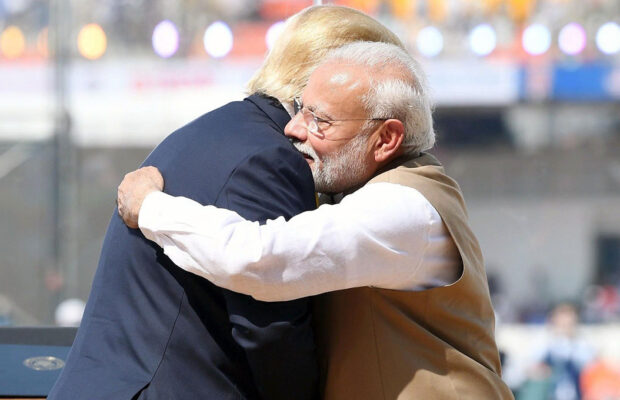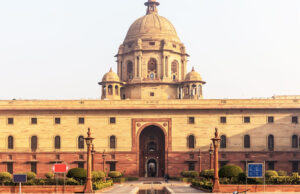A Trump Puzzle on Modi’s Lap

| PANKAJ SHARMA |  |
After Indian Prime Minister Narendra Modi’s USA visit, there are apprehensions about theprospects of the deal of F-35 stealth fighter aircrafts. There are many who find American PresidentDonald Trump’s offer tricky in many terms and put question mark as it can harm the geopoliticalinterests of India. There is a strong concern among the defence experts that Trump’s announcementmight never take a final shape.
Even if Trump’s announcement never results in an actual sale, American academicians arevery hopeful that USA will get many advantages from this offer as it remains an effective strategicmove. It not only signals trust to India along with a willingness to review export control policies, butalso counters influence by Russia, which had recently offered India fifth-generation fightercollaboration. Moreover, it forces an Indian reckoning with the incompatibility of higher qualityWestern systems and with poorly performing Russian systems, including S-400 air defencecapabilities that India has previously acquired.
Modi’s visit to Washington marked the fourth meeting between U.S. President DonaldTrump and a foreign leader since the start of the new administration. Despite differences overtariffs, Modi’s trip signalled that U.S.-Indian relations will continue along the positive trajectory seenin recent years, particularly in defence and technology cooperation. Trump made clear that he seesvalue in India’s role as a counterweight to China, but that he also views Delhi as an important playerand key partner outside the context of strategic rivalry.
US international relations experts say that Modi’s visit less than a month into the new Trumpadministration signals about the administration’s potential foreign policy priorities. They find Modi-trip marks an early and consequential foreign policy development for the Trump administration infour respects.
First, President Trump elevated India as a premier U.S. partner for his administration,notably hosting Modi before any European leader. This early, high-level engagement not onlyupgrades bilateral momentum but counters the narrative of Trump’s foreign policy approach beinginsufficiently attentive to alliances and partnerships. By prioritizing India over traditional allies andpartners, he has signalled deep interest in and a clear focus on key partnerships of the future.
Second, Trump reset the tenor of U.S.-India engagement by prioritizing immediate U.S.interests in tandem with investments in long-term objectives. Trump elevated material U.S.concerns, such as an unfavourable trade balance due to Indian protectionist policies and illegalmigration from India. This style of bargaining marks a clear break from previous approaches to India,which tended toward accepting strategic trade-offs for Indo-Pacific convergence. Trump’s instinctthat cantering American priorities proactively wouldn't compromise the relationship and insteadimprove it for U.S. interests was borne out — India offered pre-emptive tariff concessions, agreed tobroader trade negotiations, announced intent to purchase U.S. energy and committed to aggressiveaction on illegal immigration. This defies a wisdom on U.S.-India relations held by some inWashington that the U.S. must be more accommodative of India to secure meaningful cooperation.
Third, the Trump administration has set a bold agenda committing to and expandingcooperation on trade, technology, infrastructure, energy, defence and people-to-people ties. The
president has demanded more — like broader market access for American goods and services inIndia and an ambitious goal of growing bilateral trade to $500 billion by 2030 — but crucially,matched this with substantial offers to India, including support for the India-Middle East-EuropeEconomic Corridor (IMEC) initiative, technology transfers, counterterrorism and law enforcementcooperation, and a path to fifth-generation fighter jets.
Finally, Trump’s perspective on India's role regarding China suggests a distinct approach togeopolitics that goes beyond traditional balance of power considerations without dismissing them.India’s value as a critical player in the Indo-Pacific region and counterweight to China remainsimportant, but Trump appears to see India as a standalone, vital power in Asia and the globe, withwhom the United States needs a strong, sustainable partnership anchored in equitable distributionof benefits, particularly economic ones. This view, combining commercial institutionalism,reciprocity and attention to relative American gains, departs from the strategic orthodoxy of recentU.S. administrations on ties with India, which cantered on balance of power politics, and theimperative of India’s rise therein, and shared democratic values.
This view also leaves space for balance of power cooperation and encourages investment incapacities of both countries to act collectively across strategic domains — but it seeks to lower theburden America must shoulder in bilateral ties. If institutionalized, such an approach can be morerealistic and resilient than those built on elusive ideological principles, which create a mismatch ofexpectations or approaches that primarily respond to variable U.S.-China and India-China dynamics.
What did the visit tell us about how the US and India will approach top geopolitical issues?Modi’s visit comes at a time of significant flux in how Washington approaches its relationships withtop allies and adversaries alike. Despite the dizzying pace of change, India looks reasonably well-positioned to capitalize.
On Russia, Trump’s Wednesday call with Vladimir Putin and announcement of newnegotiations to end the war in Ukraine were undoubtedly music to India’s ears. Modi’s India hasretained good ties with Russia despite criticism from the West, continuing to import Russianweapons and even massively ramping up its purchase of discounted Russian oil since 2022. NowModi’s familiar talking point that India is not neutral, per se, but sides with peace, and his pointedsuggestion to Putin that “this is not the era of war,” place Modi comfortably in Trump’s camp.
On China, many of the cooperative ventures announced during Modi’s visit only make sensewithin the context of continued geopolitical competition with Beijing. Beijing’s critical reaction to thetrip shows it could easily read between the lines. Modi’s India can, for a time, breathe easier inunderstanding that Trump’s America has no plan for a “G-2” condominium with Beijing that wouldcede to China a sphere of influence in Asia as some Indian analysts have feared.
Even on Iran, where team Trump has reimposed a “maximum pressure” campaign that couldobstruct India-Iran cooperation, India has effectively hedged its bets by enhancing its ties with Israeland Gulf Arab states. Expect the IMEC initiative to get an added boost from Trump's Washington aspart of the effort to recover and rebuild after the Gaza War and to further isolate Iran.
American experts have opined that the Modi government has been looking to nuclear poweras an essential energy source for meeting the demands of India’s growing economy and seekstechnology from the United States. The needs are substantial, with the Indian governmentannouncing plans to build 100 gigawatts of nuclear capacity by 2047. The U.S. should be a naturalpartner in this effort. Civil nuclear cooperation was a foundation of the new strategic partnership
starting 20 years ago when the Bush administration began a process to bring India into the globalnuclear club even though New Delhi never signed the global Non-Proliferation Treaty (NPT).
Although the U.S.-India Civil Nuclear Agreement (also called a 123 agreement) wasannounced in 2005 and signed in October of 2008, no U.S.-origin nuclear reactors have yet beenbuilt in India due to commercial, legal and bureaucratic obstacles. One challenge was continued U.S.restrictions on working with some Indian nuclear entities. These constraints were lifted at the veryend of the Biden administration. Another hurdle has been India’s nuclear liability rules, which wereenacted in 2010. Nuclear suppliers believe India’s rules are out line with global norms and put themat unlimited risk in the event of an accident. The Indian government announced plans to revise itsnuclear liability laws just as Modi embarked on his trip to France and the United States.
With that background, Trump and Modi re-focused U.S.-India energy cooperation towardpledges for India to purchase more American oil and gas and for the U.S. to share nuclear energytechnology when India’s liability laws change. The leaders committed to old plans to build largenuclear reactors as well as possible cooperation on small modular reactors, with the joint statementincluding a commitment to “fully realize the U.S.-India 123 Civil Nuclear Agreement by movingforward with plans to work together to build U.S.-designed nuclear reactors in India through large-scale localization and possible technology transfer.”
The opinion of India’s foreign relations experts is that we should expect a fair amount ofcontinuity from the previous administrations as Trump and Modi recommitted to deepening defencetechnology collaboration and military operational cooperation over the next decade. Going forward,defence cooperation will likely remain the “load-bearing pillar” of the U.S.-India relationship.
While repackaging previous strategic technology collaborations into a new initiative,Transforming the Relationship Utilizing Strategic Technology (TRUST), the two leaders maintained avision of codeveloping and coproducing critical and emerging technologies. The leaders reaffirmedthe INDUS-X platform while modelling new INDUS acceleration initiatives off of it, including in spaceand energy.
Indian experts say that the Modi and Trump also highlighted new efforts to strengthencollaborative deterrence. On a call the previous week between defence officials, Secretary ofDefence Pete Hegseth suggested to his counterpart Defence Minister Rajnath Singh that theoverarching purpose of U.S.-India defence industrial, technological and operational cooperation was“to deter aggression in the Indo-Pacific.” The joint leaders’ statement from the Modi visit reflectsthis sentiment with efforts to operationalize deterrence, including Indian leadership in the CombinedMaritime Forces, new industrial partnerships to co-develop autonomous undersea surveillance, anda security role for the Quad (a grouping of Australia, India, Japan, and the U.S.) including maritimepatrols.
India committed to procure new capabilities to enhance Indian security burden sharing inthe Indian Ocean, including additional P-8l maritime patrol aircraft. It also indicated plans to join theliteral “arsenal of democracy” when it concludes agreements to buy and coproduce with U.S.defence firms “Stryker” infantry combat vehicles and Javelin anti-tank guided missile. Otherannouncements like the strategic minerals and undersea cables initiatives have a clear angle tocounter China’s dominance and coercive leverage in these sectors.









You must be logged in to post a comment Login